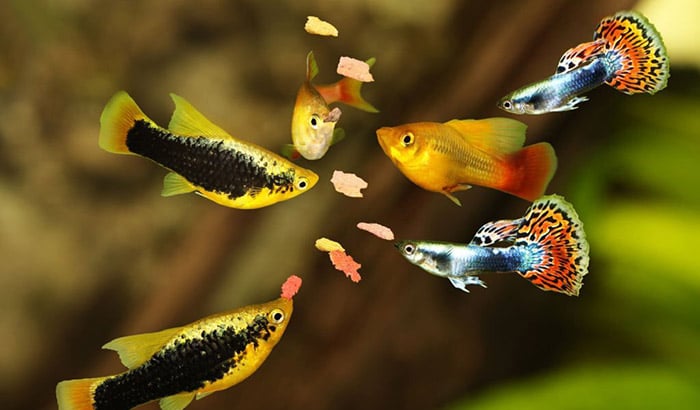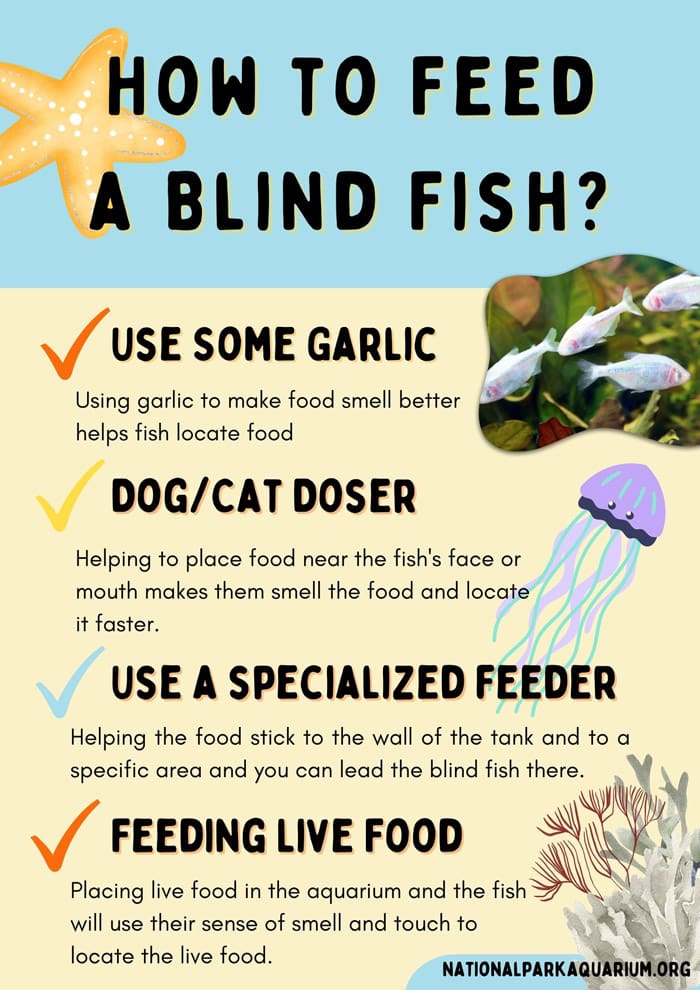Feeding fish with impaired vision can be challenging for new aquarists, as the task might require more specialized feeding techniques.
Blind fish rely on their other senses to find food, including mostly their sense of smell and touch. Because of this, it is vital to place the food in an area where the fish can easily find it.
This article National Park Aquarium will discuss the best way to feed blind fish and explore some food options available for them.
How Do You Feed a Blind Fish?
A fish can go blind due to various reasons. You might bring home a fish that has already lost its sight in either or both eyes. Fret not; here’re some methods that aquarists can use to deliver food to the fish:
Method 1: Feeding on the Surface
One way to feed a blind fish is to place the food on the water’s surface. The fish will use its sense of smell to locate the food. This method works well for small fish.
To prevent the food from floating away, we can use a feeding ring or other type of device that will keep the food in one area.
Method 2: Sinking Pellets or Flakes
Another option for feeding a blind fish is to sink the pellets or flakes. It is advisable to put the food in a cup and sink it into the water.
This method works well for larger fish that cannot reach the food at the surface of the water.
Method 3: Feeding Live Food
A third option for feeding a blind fish is to use live food. You can place live food in the aquarium or by using a live food culture.
The fish will use its sense of smell and touch to locate the live food. This method is best used as a supplement to other methods of feeding.
Method 4: Use Garlic To make the food smell
Since we should help the fish locate the food, it is recommended to heighten the food smell.
Garlic is a good choice, even in water, and fish love garlic. Therefore, you can dip the small pieces of good in garlic and put them into the tank.
Method 5: Use a dog doser
When other methods mentioned above do not work, we might have to put more effort and time into feeding our fish.
With that, using a dog doser to place the food near the fish’s face or mouth increases the chance of them smelling the food and locating it faster.
Method 6: Use a specialized feeder
There are fish feeders designed with suction power. Therefore, it helps the food stick onto the tank wall and one specific area.
Therefore, as the food is located in the same place, you can lead the blind fish there.

What are the tips for Feeding Blind Fish?
Here are some tips to keep in mind when feeding a blind fish:
1. Feed small meals.
Aquarists should feed their blind fish small meals several times per day. This will help ensure the fish get the nutrition they need without overfeeding them.
2. Combine various methods.
To help the fish find the food, you can use several methods and make that a habit for the fish.
Offer a variety of food types. Blind fish should be offered a variety of food types to ensure that they get all the nutrients they need.
We should take care not to overfeed their blind fish. It is easy for blind fish to miss the food that has been placed in the tank.
As a result, they may consume more food than they need and become overweight. Overfeeding can also lead to health problems such as swim bladder disease.

What Should I Feed My Blind Fish?
There are a few things to consider when selecting food for your blind fish.
First, the food should be small enough for the fish to eat.
Commercial foods designed for blind fish are available from many pet stores and online retailers.
These foods are typically made from pellets or flakes sinking to the tank’s bottom. Therefore, it is easy for blind fish to find and consume food.
Blind fish are also able to eat live foods.
Many aquarists choose to feed their blind fish live brine shrimp or bloodworms. These foods can provide a nutritious meal for your fish. Live foods can also be used as a training tool to help your fish learn to eat prepared foods.
Tips for keeping your blind fish healthy and happy
- Check the water quality regularly. Blind fish are especially sensitive to poor water quality, so keeping a close eye on things like ammonia, nitrite, and pH levels is important.
- Keep the tank clean. As with all fish, regular water changes and gravel vacuuming are crucial for keeping the environment healthy.
- Feed high-quality food. Since blind fish can’t see their food, it’s important to choose a highly nutritious and easy-to-digest formula.
- Provide hiding places. Blind fish may feel vulnerable without the ability to see predators approaching, so be sure to provide plenty of rocks, plants, and other objects for them to hide behind if they feel the need.
- Be careful when handling. Since blind fish can’t see you coming, So, be extra careful when scooping them up in a net or moving them to another tank. Gently cup your hands around them and support their body as you lift them out of the water.
Conclusion
Despite the challenges, blind fish can still lead happy and fulfilling lives. By providing them with a stimulating environment and plenty of food with how to feed a blind fish, we can help them thrive. Aquariums can provide a great home for these fish, and with careful maintenance, they can be a joy to watch and care for.
If you’re interested in helping out our little friends from the dark depths of the caves, consider setting up an aquarium at home and donating to your favorite blindness research charity. Thanks for reading!




